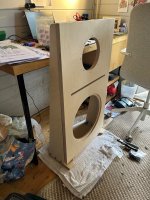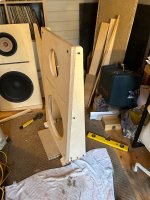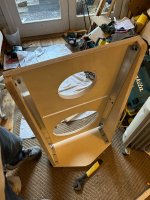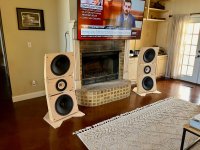Not in my experience.I hope they cross over ir very high then...
But what about an OB with a non dipolar tweeter? Does it sound not weird?
Looks mid-century in design, something other speaker design artists can expand upon.
In line with a few others here, I’ve just fired up my PAP Duet 15 Prelude clones this evening. The missus is NOT happy, but I am! Much to do, and I suspect that the Eminence Betas will go in favour of a pair of Alphas and I may tone down the Tang Band 1808 another notch (running the 3.3ohm resistor in parallel at the moment) but I’m totally smitten with the way these present music already, compared to my Cambrian period Living Voice Avatars. I actually have mids now! 😂
Oh well, it’ll be more DIY on the house to ‘pay the debt’ for these!

Oh well, it’ll be more DIY on the house to ‘pay the debt’ for these!
Attachments
Man - I just got these together, using the Alpha's. I have all the XO parts, but have never built a crossover (scratching my head). I'm trying to determine if I can find someone to assemble the crossover, or if I should order the Sublime K231 (and spend the extra $$$) after already ordering good XO parts. I have 4 additional Alpha's if I can be successful in the XO piece and want to take the project further. Any, and all, recommendations are appreciated ?
Attachments
Looking good! If these are Trio clones, some kind fellow has a schematic on YouTube you could use, plus it’s bloody good fun making your own! Try this
Nice 🙂... Much to do, and I suspect that the Eminence Betas will go in favour of a pair of Alphas...
View attachment 1437152
In my exeprience , I found that Eminence Beta 15 has a better bass than Alpha 15, but only if biamped and EQ-ed. In case of fully passive ones, Alphas may be a better choice.
Vix could you give more detail on the beta VS alfa ? what are the issues ?
I assume the lower Qts of the Beta is likely giving you more control in the bass
Also I assume the strong rise in freq response starting much earlyer on the Alpha causing issues with passive crossovers?
I assume the lower Qts of the Beta is likely giving you more control in the bass
Also I assume the strong rise in freq response starting much earlyer on the Alpha causing issues with passive crossovers?
Last edited:
BTW is has anyone tryed this woofer?
https://www.madisoundspeakerstore.c...udience-bianco-15ob350-15-open-baffle-woofer/
Its price is competitive with some mentioned here BUT its parameters are optimized around open baffle use specifically. I am most impressed with the Xmax at 2-3 times many of the woofers mentioned in this thread AND I suspect its suspension is carefully tailored to self limit at xmax a bit better than woofers not designed as open baffle use.
its freq response is quite linear with a first brake at around 500 hz so its outside the typical 200-300 hz crossover point used in most open baffle designs
Only potential ? issue I see is its moving mass is higher than the Eminance drivers. Perhaps not an issue at all on reasonably thick and heavy open baffle frames
https://www.madisoundspeakerstore.c...udience-bianco-15ob350-15-open-baffle-woofer/
Its price is competitive with some mentioned here BUT its parameters are optimized around open baffle use specifically. I am most impressed with the Xmax at 2-3 times many of the woofers mentioned in this thread AND I suspect its suspension is carefully tailored to self limit at xmax a bit better than woofers not designed as open baffle use.
its freq response is quite linear with a first brake at around 500 hz so its outside the typical 200-300 hz crossover point used in most open baffle designs
Only potential ? issue I see is its moving mass is higher than the Eminance drivers. Perhaps not an issue at all on reasonably thick and heavy open baffle frames
A long time ago (17 years or so ago) I had built an OB with Beta 15 and Visaton B200. I had chosen Betas because I was thinking they would give me better, tighter bass. It was done with a passive crossover. I spent (lost) months trying to get it to work. Nope.Vix could you give more detail on the beta VS alfa ? what are the issues ?
I assume the lower Qts of the Beta is likely giving you more control in the bass
Also I assume the strong rise in freq response starting much earlyer on the Alpha causing issues with passive crossovers?
At a friend, I had heard a pair of Alphas on OB. While the bass could not have been described as "punchy" it was sufficient.
In a despair, I built an active crossover, something similar to Nelson Pass SLOB.
Then it was good.
So, a lesson that I learned:
All of mentioned woofers can work in Open Baffle, but it all depends on how are you using them. Passively, you really need a high Qts woofer (i.e the Alphas or similar) to counter the baffle loss.
There should be no problem with a passive crossover and Alphas. It just has to be dialed in accordingly. If you are using an efficient fullrange, then two Alphas are recommended, otherwise fullrange will have to be tamed down, which is a less preferred solution, but necessary in order to preserve the tonal balance.
I hope I helped a bit 🙂
thanks that does help a bit
However could you tell what crossover point and slope you were trying when you things were not working well?
I have noticed with passive crossovers in these designs that there can be huge differences in ability to get a punchy dynamic quality going from a 12 db cross to an 18db cross when crossing at around 250-300 hz. The 18db and a bit higher cross point gives much better dynamics
Also find that often a 150-200 hz passive crossover always seems to give a "polite" sound but no dynamics.
Sure in theory the 150-200 cross is "correct" for baffl loss BUT in room things dont necessarily follow theory all that well BUT I admit this is all with passive crosovers and perhaps with active the dynamics return with the lower crossover points?
However could you tell what crossover point and slope you were trying when you things were not working well?
I have noticed with passive crossovers in these designs that there can be huge differences in ability to get a punchy dynamic quality going from a 12 db cross to an 18db cross when crossing at around 250-300 hz. The 18db and a bit higher cross point gives much better dynamics
Also find that often a 150-200 hz passive crossover always seems to give a "polite" sound but no dynamics.
Sure in theory the 150-200 cross is "correct" for baffl loss BUT in room things dont necessarily follow theory all that well BUT I admit this is all with passive crosovers and perhaps with active the dynamics return with the lower crossover points?
It was quite a long time ago. I know I tried a zillion passive combinations and got tired of it. First order, second order, T bass, what not...
The issue is that a low Qts woofer will starts rolling off early, it has to be compensated somehow. Passively, it is much harder (for me it was impossible) than actively. On the other hand, a high Qts woofer gets "natural" compensation.
By the way, maybe you saw this thread:
The issue is that a low Qts woofer will starts rolling off early, it has to be compensated somehow. Passively, it is much harder (for me it was impossible) than actively. On the other hand, a high Qts woofer gets "natural" compensation.
By the way, maybe you saw this thread:
A rarely discussed crossover is the Series Crossover (in contrast to the universally popular Parallel Crossover). It offers considerable advantages especially with a subwoofer and a bass midrange. I used a series passive crossover in the Bitches Brew Live Edge Dipoles (which are featured in the new October 2023 issue of AudioXpress). Here is the schematic:

ABOVE: In a series crossover, you wire the woofer and midrange in series. You short the woofer with a capacitor. You short the midrange with an inductor.
The circuit above is what I used in the Bitches...
ABOVE: In a series crossover, you wire the woofer and midrange in series. You short the woofer with a capacitor. You short the midrange with an inductor.
The circuit above is what I used in the Bitches...
- perrymarshall
- Replies: 145
- Forum: Multi-Way
I see and thanks for that
Im presently using a higher sensitivity "pro" woofer and yes the roll off in the bass is an issue
However once ya tack a 200-300 hz crossover on it the response is much flatter down below its normal roll off. Example. My .35 Qts woofer is about 5 db down at 50 hz in a smallish baffle of only 22 inches wide by 30 inches tall.
I admit however that there are useful improvements in sound to get even another 10 hz lower 😉 and a 28 inch affle did tha BUT its too big a speaker for my taste
I stayed with the higher sens woofer because I wanted a smaller sized speaker and needed the extra 10 db sensitivity over the planar mid/tweeter so that once all was tuned right ya end with right tone overall BUT perhaps the high Q woofer would do the same? My concern is the small X max on the Eminence. I would like to get 105 db but suspect the small xmax may limit things here
Im presently using a higher sensitivity "pro" woofer and yes the roll off in the bass is an issue
However once ya tack a 200-300 hz crossover on it the response is much flatter down below its normal roll off. Example. My .35 Qts woofer is about 5 db down at 50 hz in a smallish baffle of only 22 inches wide by 30 inches tall.
I admit however that there are useful improvements in sound to get even another 10 hz lower 😉 and a 28 inch affle did tha BUT its too big a speaker for my taste
I stayed with the higher sens woofer because I wanted a smaller sized speaker and needed the extra 10 db sensitivity over the planar mid/tweeter so that once all was tuned right ya end with right tone overall BUT perhaps the high Q woofer would do the same? My concern is the small X max on the Eminence. I would like to get 105 db but suspect the small xmax may limit things here
I started a with high Q woofer on my open baffles. AE dipole to be exact. Plenty of low end even when not eq'd. But it never sounded as precise as I thought it should. I swapped to a low Q, pa style woofer from B&C, applied massive EQ and that solution suited my tastes better. I was not attempting full range though, as a subwoofer was always planned for under 60hz.
@studiotech
Can I ask you which PA driver you used?
I ask because I also use subs (4x 12" sealed) below the dipole and using an 18" Faital 18hp1010 as midbass and haven't been so happy with it playing 80 to 300Hz.
I'm now building a SLOB with 8x 6.5" per side to see if I like it better. Maybe OB midbass isn't for me. Or maybe I didn't dial the 18" correctly.
Can I ask you which PA driver you used?
I ask because I also use subs (4x 12" sealed) below the dipole and using an 18" Faital 18hp1010 as midbass and haven't been so happy with it playing 80 to 300Hz.
I'm now building a SLOB with 8x 6.5" per side to see if I like it better. Maybe OB midbass isn't for me. Or maybe I didn't dial the 18" correctly.
Is there really any 18 inch that can behave well into the mids?
the 18hp1010 shows a break right at 300 hz that I would expect to play hell with a 300 hz crossover
open baffle bass has potential to outclass most pistons in a box imo
Im using a parts express 12 in pa310 I believe, its really quite good crossed at 18db at 300 hz
the 18hp1010 shows a break right at 300 hz that I would expect to play hell with a 300 hz crossover
open baffle bass has potential to outclass most pistons in a box imo
Im using a parts express 12 in pa310 I believe, its really quite good crossed at 18db at 300 hz
15NDL76. Nothing too special, but it worked out and I never felt the need to upgrade and further. I'm using it 60-250.
As I said, in my experience, mid-Qts woofers work better, but only if done actively + EQ. Passively, I don't see a way to sufficiently boost the bass...
- Home
- Loudspeakers
- Multi-Way
- Ultimate Open Baffle Gallery




